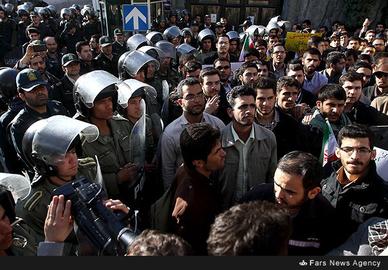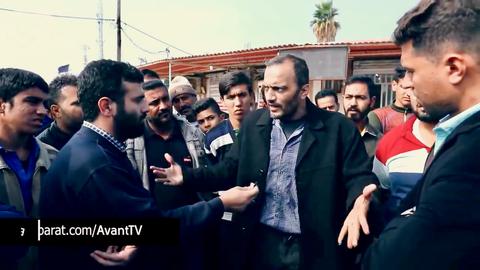On November 15, the Iranian government announced a sudden, steep rise in fuel prices for private use. The government increased prices by 50 percent for the first 60 liters of gasoline purchased per month, and 200 percent on purchases above 60 liters.
Based on the new rates, an Iranian worker can buy about 4.6 liters of gasoline with their minimum hourly wage (for the first 60 liters purchased per month), and 2.3 liters of gasoline with their hourly wage (on purchases above 60 liters). For comparison, an American worker can buy about 9.4 liters of gasoline with their hourly wage, while the equivalent cost for a British worker is approximately six liters.
The announcement of new fuel prices led to a series of street protests, which continued for at least four days and turned into the bloodiest public protests the Islamic Republic of Iran had ever witnessed. So what were the most outstanding characteristics of Iran’s November protests, and what made this episode a turning point in Iran’s post-revolution history?
Unprecedented Casualties
According to an Amnesty International report published on December 16, at least 304 people were killed between November 15 and 18. This figure is higher than the number of casualties in the January 2017 protests (about 30 individuals), the post-2009 election uprising (about 80 people), and any other street protest since the establishment of the Islamic Republic of Iran. It must also be noted that Iran’s security forces have been pressuring the families of the November protesters to keep silent, so the real number of the November casualties might be much more than the Amnesty estimates.
According to Hossein Naghavi Hosseini, the spokesman for the Iranian parliament’s National Security Committee, about 7,000 protesters had been arrested up to November 26. In addition, thousands of protesters were injured, and so far no exact figure has been published regarding these injuries. Government sources say seven security forces or government employees also lost their lives during the protests.
Unprecedented Extent of the Protests
The number of cities where protest gatherings were held in November 2019 was more than that of any other uprising in the history of the Islamic Republic.
On November 21, Ramazan Sharif, the Revolutionary Guards’ spokesman, said protest gatherings had taken place in about 100 Iranian cities. However, on November 29, Yadollah Javani, the political deputy of the Revolutionary Guards commander, presented updated information that indicated an even greater number of cities had been involved in the protests. He said protests occurred in 29 out of 31 Iran’s provinces, adding that the 2009 and 2017 protests were “far less widespread” than the November 2019 uprising.
It is important to note that in 2017, the Ministry of Interior reported that protests had been held in about 130 cities. In addition, the 2009 protests mainly took place in Tehran and in fewer than 10 other cities (However, on June 25, 2009, more than a million people participated in a protest rally in Tehran, a record that has not been broken so far during any protest).
Unprecedented Shut Down of the Internet
On November 16, a day after the protests erupted, Iran’s Supreme National Security Council decided that the internet should be shut down as long as the uprising continued. This decision was aimed at preventing citizens from publishing and sharing news, pictures and videos of the protests; to prevent protesters from communicating, and so that international media could not report on the ongoing uprising.
In Iran, a huge number of foreign-based media outlets, websites and social media platforms have been filtered for many years. But during the November uprising, for the first time, the internet was completely shut down. This shutdown was possible thanks to the costly, nationwide government project to create a parallel state-run intranet, which enables the authorities to disconnect the country from the World Wide Web at times of security crises. According to NetBlocks, a non-governmental organization that monitors cybersecurity and the governance of the internet, the Iranian government’s action reduced national connectivity to five percent of its pre-protests level. During this period, only a tiny minority of people who benefitted from exclusive internet connections provided by some government institutions managed to access the World Wide Web. The rest of the population was only able to access Iran’s so-called National Internet.
The shutdown continued until November 20, when the internet was gradually reconnected in the provinces where the protests had been crushed.
The Nature of the Protests
The November uprising was rooted in economics. No wonder that at the beginning of the protests, some slogans — such as “Death to high prices” and “Fuel has become more expensive, the poor have become poorer”— succinctly expressed people’s economic demands. However, very soon the slogans turned political. These political slogans were more radical in places where the government crackdown on the protesters was more brutal.
Some slogans directly attacked the Iranian regime and the high-ranking authorities, for instance: “Death to Khamenei,” “Death to the dictator,” “Death to the Islamic Republic,” “Death to Rouhani,” “Beware Khamenei! We are people, not thugs,” “The Leader reigns like God, the people live like beggars,” “Clerics must get lost,” “You exploited Islam, you exhausted the people.”
Other chants voiced anger against the economic consequences of the Islamic Republic’s foreign policy, and especially Tehran’s costly intervention in the region. They included: “No to Gaza, no to Lebanon, we sacrifice our lives for Iran,” “Oil money has been lost, it has been spent on Palestine,” “We have neither money nor fuel, to hell with Palestine,” “Syria is short of money, but what is the fault of the people?,” “Our enemy is right here, they lie when they say it [the enemy] is America.”
Some slogans were even in support of the pre-Islamic Republic Pahlavi Dynasty, including: “What a mistake we made by staging the revolution!,” "Oh Shah [Crown Prince] of Iran, return to Iran!,” “Bless your soul Reza Shah [the founder of the Pahlavi dynasty],” “Where are you Crown Prince? Save Us!”
In summary, the protesters had economic demands, but they apparently believed that as long as the existing authorities or current political establishment are in place, their economic problems will continue. This was how the people’s economic demands turned into politics.
Khamenei’s Decisive Role
One specific characteristic of the November protests was the Leader’s immediate involvement — in both increasing fuel prices and the crackdown on the protesters.
On November 17, the leader strongly supported the increase in fuel prices, a decision that had been taken by the heads of the three branches of the government during a meeting of the Supreme Council of Economic Coordination, a body that was established in May 2018 on order of Ayatollah Khamenei to counter the effect of US sanctions. This council commands authority above the parliament and members of parliament could not intervene in its decisions. After the beginning of the unrest, a group of parliamentarians tabled a motion to reverse the increase in fuel prices, but the Leader sent a written message to MPs to prevent them from opposing the decision. The message was issued on November 17, on the same day that he made a public statement in support of the price increase.
As part of the same public statement, delivered just two days after the beginning of the protests, the Leader said protesters who undertake actions such as “setting fire to banks” are “thugs and hooligans,” not “ordinary people.” For comparison, it is worth noting that the Leader’s first reaction to the January 2017 uprising came about 12 days after the protests had erupted, when the security forces had already cracked down on the protests. But in November 2019, he reacted immediately to the uprising by issuing a strong statement against those protesters whom he labeled as “thugs and hooligans.”
This reaction played a decisive role in the security forces’ pattern of cracking down. In November 2019, the police opened fired on the protesters right from beginning, which led to unprecedented casualties in various cities. This happened despite the fact that during Iran’s previous public protests, the police first tried to disperse the protesters by beating them up and frightening them, rather than opening fire from the beginning.
The fact that many of the killed people had not committed any violent act showed the extent to which the police felt free to shoot ordinary protesters. The number of such individuals was so considerable that on December 4, the Leader approved a proposal put forward by Iran’s Supreme National Security Council to compensate families of “the victims who had no role in the recent protests and unrests.”
A Turning Point for Rouhani
Over the course of the 2013 and 2017 presidential elections, Hassan Rouhani tried to portray himself as an advocate of human rights and prosperity in Iran. As president, he prioritized the 2015 nuclear deal over all other campaign promises, which disappointed many of his voters. Afterward, Donald Trump’s unexpected rise to the presidency and his withdrawal from the nuclear agreement had a devastating effect on Iranian economic conditions as well as Rouhani’s popular support.
However, the November 2019 events might have eradicated what had remained of Rouhani’s reputation. He not only had a major role in the increase of fuel prices, he also strongly supported the security crackdown on protesters. On November 20, President Rouhani publicly asked the judiciary to identify and punish those drivers who had created “traffic jams” as an act of protest. On December 4, he even supported the public broadcast of the “confessions” of arrested protesters, despite the terrible reputation Iran’s security agencies have for extracting forced confessions from their detainees under torture.
These stances from the president led to massive criticism, not only from the Iranian opposition, but also from many reformists who had supported Rouhani in presidential elections. On the other hand, Rouhani’s response after the recent uprising undermined the credibility of the political forces that had supported him during the last presidential contest.
Given that all these developments have taken place two months before Iran’s next parliamentary elections, it seems likely that the events in November will have a serious impact on Iran’s elections. Following the protests, many of Rouhani’s previous supporters have openly stated that they will not vote in the upcoming election. Some of them have even apologized and expressed remorse for having participated in the country’s previous elections.
Overall, according to many Iranian analysts, Rouhani’s performance and behavior during the November events has paved the way for the conservatives’ electoral victory in February 2020’s parliamentary election, and this could even lead to similar developments over the course of the 2021 presidential contest.
More in this series:
Decoding Iran’s Politics: The Revolution Online
Decoding Iran’s Politics: New Sanctions and Public Protests
visit the accountability section
In this section of Iran Wire, you can contact the officials and launch your campaign for various problems


























comments